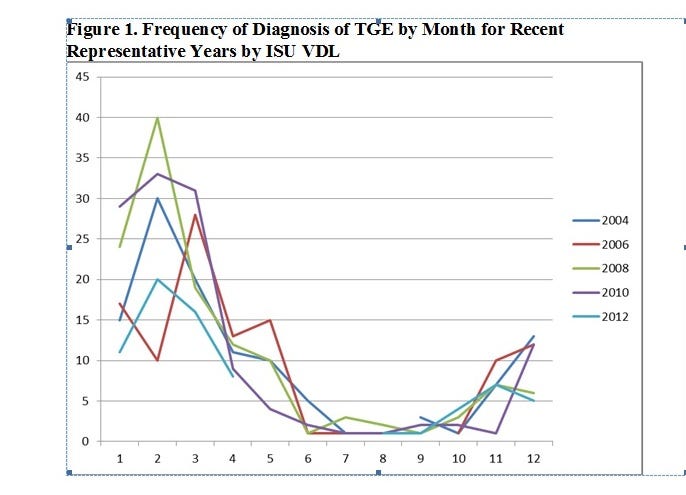June 3, 2013

Diarrhea in pigs is common. Outbreaks of diarrhea can be caused by many different infectious agents as well as a host of noninfectious causes and risk factors. Accurately diagnosing the cause(s) of diarrhea by clinical examination is challenging because the characteristics of feces are not specific for a particular cause. More than one cause or risk factor may be present.
The list of infectious contributors is fairly long and has recently increased with introduction of a disease new to the United States. Known as porcine epidemic diarrhea (PED), this diarrhea is caused by a virus known as porcine epidemic diarrhea virus (PEDV). PEDV is closely related to the virus that causes Transmissible gastroenteritis (TGE). Even though the two diseases are caused by similar viruses (coronavirus), the two viruses are not cross-protective. In other words, pigs exposed to one of the viruses will not become immune to the other.
TGE History, Cases
TGE has been endemic and feared in the United States for at least 70 years because it causes epidemics of diarrhea in all ages of susceptible pigs, with high mortality (up to 100%) in suckling pigs. TGE outbreaks are more common in the cold seasons in the United States (Figure 1), with a similar pattern of seasonal occurrence for every year for which there are records. This is because the virus is more rapidly deactivated by heat and ultraviolet radiation of summer.

Most TGE outbreaks in recent years have occurred in grow-finish pigs, presumably because of less stringent biosecurity. Outbreaks within sow farms that have very good biosecurity are relatively infrequent in recent years (personal observation).
Figure 2 illustrates the frequency of TGE cases detected by the Iowa State University Veterinary Diagnostic Laboratory (ISU VDL) over the past 17 months. The total cases detected in winter/spring of 2012 were fewer than expected from historical data, presumably because of the unusually mild winter a year ago.

The number of TGE cases detected in 2013 is very similar to the numbers expected in a “normal” year (Figure 1). Anecdotal reports from swine veterinarians in the Upper Midwest suggest that more TGE cases than usual occurred in grow-finish stages during the months of April and May, presumably because of the cooler weather experienced in those months.
PED Virus Identified
The ISU VDL was presented with several cases of TGE-like disease from sow farms in May 2013, which was unusual. Morbidity and mortality in sucking piglets were very high. Routine testing for TGE was negative, which quickly led to deeper investigation and the discovery of the PED virus in those herds. Since PEDV was not previously found in the United States, the National Veterinary Services Laboratory (NVSL) provided the official confirmatory testing.
Like what you're reading? Subscribe to the National Hog Farmer Weekly Preview newsletter and get the latest news delivered right to your inbox every Monday!
In the weeks following the initial detection of PEDV, the frequency of detection of cases of TGE has decreased to nearly zero at ISU VDL, yet the number of cases in which PEDV is detected has increased (unpublished data). Several score of cases of PEDV have been detected in at least five states, usually from unrelated farms, and have been detected in both sow farms and grow-finish farms. The source (s) of introduction of PEDV to the United States are not known. Accurately predicting the future is impossible, but PEDV clearly has the potential to become very widespread if not rapidly identified and controlled.
PEDV vs. TGE
What’s the difference between PEDV and TGE at the farm level? Until we have reason (data) to believe differently, most consider the clinical signs, impact, spread of disease and control methods to be quite similar between the two diseases. However, PEDV has the potential to be more severe than TGE because all U.S. swine are susceptible, and there is no cross-protection with porcine respiratory coronavirus (PRCV) or TGE.
The diagnosis of PEDV and TGE is not particularly difficult when occurring alone and not complicated by other agents or factors. One expects an epidemic of diarrhea affecting all ages of pigs. Guidelines for diagnosis of porcine diarrhea can be found on the ISU VDL Web site:
http://vetmed.iastate.edu/vdpam/disease-topics/porcine-epidemic-diarrhea-ped-diagnostic-testing
If PEDV becomes endemic in herds or swine-producing areas, it will become less obvious clinically and, similar to TGE, an accurate diagnosis will require increasingly greater diligence in clinical observation and in proper sampling for diagnostic testing. Tables 1 and Table 2 list some very basic considerations for laboratory submission.


Diagnostic Investigation
Properly executed sample collection and preservation should allow for accurate diagnosis of nearly all infectious agents involved in outbreaks of diarrhea. Working with their veterinarian, producers must be willing to allow sampling of acutely affected pigs and, if necessary, allow for euthanasia, necropsy and sample collection from acutely affected individual pigs with typical clinical signs.
The value of sacrificing one or two pigs for accurate diagnosis pales in comparison to the cost of an inaccurate diagnosis, inappropriate treatments, costs of veterinary service and diagnostic testing. While taking the time and effort to collect appropriate samples seems easy and obvious, personal experience would suggest that it could be improved in many situations. Also, providing basic information on laboratory submission forms (age, morbidity, mortality, clinical signs) is extremely valuable in conducting a cost-effective diagnostic investigation.
You might also like:
Researchers Investigate Novel Pig Stress Syndrome
You May Also Like



